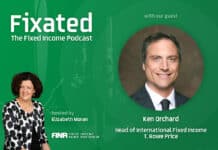
By Kellie Wood, Head of Fixed Income at Schroders

The third quarter of 2025 delivered strong performance across global asset markets, with the United States leading the way in economic growth. Macroeconomic data continues to paint a solid picture. Jobless claims remain low, core capital goods orders have increased, and second quarter GDP was revised upward to an annualised rate of 3.8%, driven largely by consumer spending.
Despite this momentum, labour markets remain soft, creating a disconnect between output and employment. Consumer spending continues to be supported by wealth gains and lower saving rates but weakening labour income in the U.S. raises concerns about the durability of the expansion.
The US Fed has resumed its rate-cutting cycle, with further easing expected into 2026 to prevent financial conditions from tightening. While some of the slowdown is structural- such as reduced labour supply, shocks earlier in the year also contributed to the deceleration in payroll growth. Inflation remains moderate. The PCE deflator rose 0.3% month-on-month and 2.7% year-on-year, while core PCE increased 0.2% month-on-month and 2.9% year-on-year. These figures are slightly above the Federal Reserve’s target but still within a historically acceptable range.
Several structural factors continue to underpin economic activity. Investment in AI-related technology is driving capital expenditure, healthcare employment remains steady, likely due to demographic trends and gig economy jobs are helping support lower-income cohorts. In the tech sector, productivity gains are evident, with output rising even as employment in computer manufacturing declines. Corporate profits also remain positive year-on-year, providing support for upper-income households and asset owners.
Emerging risks to market stability
Market volatility has declined significantly, driven by a stable macroeconomic backdrop and muted inflation pressures, and most G10 central banks are maintaining steady policy stances. However, risks are building beneath the surface. U.S. policy developments with tariff policy and elevated equity valuations remain key concerns.
Also read: Pengana Global Private Credit Trust Offers Additional Units
The equity risk premium is near levels last seen before the dot-com bubble burst, and the Federal Reserve’s current policy stance is unlikely to deflate this valuation excess. Factors such as renewed debate over Fed independence, fiscal pressures, and stronger-than-expected economic data could all contribute to upward pressure on long-term yields. Recent data surprises – including strong consumer spending and jobless claims – suggest that growth and inflation may accelerate further, complicating the Fed’s dovish stance. All could disrupt the current calm. While no single catalyst for volatility is immediately apparent, the list of potential triggers is growing as we move into the final quarter of the year.
Credit outshines bonds
Corporate credit has continued to outperform sovereign bonds throughout 2025. Strong corporate earnings, central banks supporting growth via policy easing and inflation moderating has contributed to strong compression in credit risk premiums across global credit markets. Rate cuts implemented in non-recessionary environments have typically led to corporate credit outperforming government bonds in the lead-up to the cuts.
From a valuation perspective, corporate credit currently appears expensive, especially high yield credit. As central banks move policy rates back to more neutral levels, we are expecting less outperformance and investing in credit assets for high quality income in this environment.
With credit valuations very stretched in the US, we continue to favour European and Australian investment grade assets, including residential mortgage-backed securities and higher yielding subordinated debt that are providing more attractive valuations and a supportive cycle. Local currency emerging market debt continues to perform strongly. We maintain a constructive outlook for emerging market debt, supported by appealing real yields and a weaker U.S. dollar.
We have continued to reduce our interest rate risk vs the benchmark. In Australia, the latest monthly inflation data surprised to the upside with the details showing services inflation is significantly higher than expected. For the RBA, this means considerably less certainty that inflation has settled near 2.5% and highlights the likelihood that it will take a period of modestly restrictive policy for inflation to return to target. This also comes at a time when growth has been picking up, driven by domestic consumption off the back of recent interest rate cuts. Australian bond yields have been rising as the market anticipates less cuts will be required over the next year.
US bond yields moved lower at the start of the month as the Fed cut by 25bps, only to retrace higher into the end of the month. Through mid-September, the market was pricing a cash rate of 2.85% over the next year. We view this level to be excessively priced and started to reduce US interest rate risk. Economic growth has since reaccelerated, driven by stronger consumption.
Overall, we have moved short duration vs our benchmark, positioning for higher yields as markets are fully priced for policy easing and growth is now accelerating in the US, Australia and Europe. We are also short Japan interest rates as the Bank of Japan (BoJ) moves to hike policy rates in October with inflation more embedded within the Japanese economy.





























